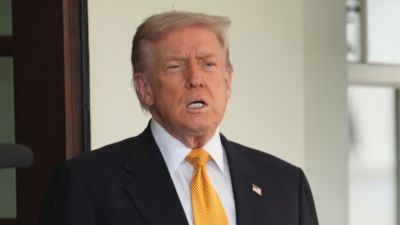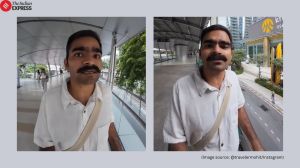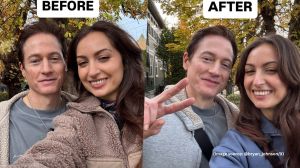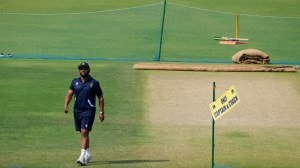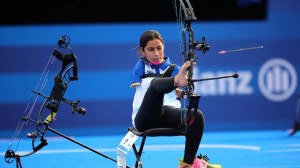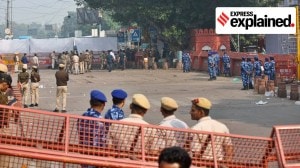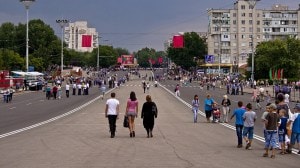He was more contemporary than any of the artists I know: Atul Dodiya remembers Tyeb Mehta in his centenary year
One of India’s foremost modernists, Mehta painted the silence and anguish of the human soul
 Atul Dodiya with Tyeb Meha (Photo courtesy - Chemould Prescott Road)
Atul Dodiya with Tyeb Meha (Photo courtesy - Chemould Prescott Road)Extremely warm and unassuming in personal life, Tyeb Mehta was very different when it came to art. Deeply committed, he was perceptibly particular about how he wanted a work to be and expected the same clarity and discernment from others. A man of few words, he seldom prescribed what should be done but he was forthright about what should not be done.
I often say that art should not be considered a stepping stone to name, fame, success and money — this conviction stems from the time I spent with Tyeb. He always said, ‘You are not painting for anybody, but because there is deep emotion within you that demands expression’. He warned us against surrendering to market temptations and to not merely repeat what is admired, but to follow our instinct and let our work evolve organically.
My introduction to Tyeb’s art, like that of several other modernists, was through reproductions in a magazine. At 16, his first original work that I saw was not a painting but his film Koodal, screened by a film society I was part of. I had read Satyajit Ray’s praise for the film Koodal in Ray’s book Our Films, Their Films, and watching it I realised how it revealed his powerful command over cinema, where each frame pulsated with raw energy.
His art reflected the same intensity, with dynamic form and the plasticity he achieved through the use of solid colours to flatten the image. On closer engagement one would realise how he created such diverse universe of imagery with select subject matter and elements – trussed bull, rickshaw puller, falling figure, Kali and Mahishasur.
For years, I thought Tyeb was based in Delhi. It was serendipitous when someone introduced us to each other at a poetry reading session organised by the Gujarati Literary Circle in Mumbai, and I realised I had seen him from a distance so many times before. Meeting a legend like him, I felt very much like a fan and didn’t quite know what to say but he was extremely gracious and invited me to his Juhu home studio. That was the beginning of our long association.
I visited his home several times subsequently, often walking with him on the beach and to Akbar Padamsee’s studio, which was a ten-minute walk. Akbar would make tea for all of us and we’d chat for hours, discussing the work of great masters such as Henri Matisse, Pablo Picasso as well as writers and poets. Though both of them had much in common and were in the truest sense deep thinkers, there was also much that set them apart.
Akbar was more practical when it came to advice on matters such as where to exhibit and so on, while Tyeb was stricter. If Akbar was like a mother who would comfort you, try to resolve your problems, Tyeb was like a father who instilled discipline and who you would be a little afraid of.
Tyeb and I also shared common interest in cinema, films of (Andrei) Tarkovsky and (Ingmar) Bergman. His family owned cinema halls in Pune, and he had a very deep understanding of the medium. I also still recall having an in-depth discussion with him on Italo Calvino’s Six Memos for the Next Millennium. Later, Anju (wife and artist) also occasionally accompanied me to their studio. She still considers it one of her life’s biggest honours that Tyeb lent her a book, French writer-philosopher André Malraux’s The Voices of Silence.
I would often come back home and share my experience of being amidst such greats with my parents. I even had a reproduction of a Tyeb work purchased from the Lalit Kala Akademi for Rs 9 adorning the walls of my room. In fact, when my family was sceptical about a career in art, I would cite their example.
We visited several exhibitions together, including Akbar Padamsee’s retrospective at Jehangir Art Gallery, Prabhakar Barwe’s solo at Chemould Art Gallery and a show of Bhupen Khakhar’s drawings and watercolours at Prithvi Theatre, where Tyeb’s wife Sakina used to manage a bookstore.
Though I was always conscious about showing him my work, he did see it at exhibitions. One such occasion was in 2000 at Sakshi Gallery. In one of my paintings, Ascent, I had referenced Marcel Duchamp’s work With My Tongue in My Cheek (1959). Tyeb asked me how that reference was suitable for my work, given that Duchamp had created it in the post-war period. At the end of 20th century in India, we weren’t going through a similar situation. All I could say was, “What can I do if this man, Duchamp, comes to my studio in Ghatkopar every morning and bothers me?” At that point, he shrugged it off. But the next morning, he called me and said he had thought about the painting and the references to the European masters in my work and I could do that. That was reassuring. He had strong likes and dislikes and his approval mattered to us. He was more contemporary than any of the artists I know, and extremely aware of what was happening.
When I was leaving for Paris in 1991 to study at the École des Beaux-Arts, Tyeb told me that one of my greatest advantages was that Raza was there and that I must meet him. He also told me to visit all the museums and galleries and to see the works of the masters, from the pre-Renaissance to modern and postmodern. Viewing, he said, was the key to learning, rather than listening to lectures, which are influenced by personal opinion. When I asked him what I was supposed to observe in works, he told me to simply stand in front of a painting and look and that it would start speaking to me. I shouldn’t try to dig or analyse, the work would speak for itself. I still strongly believe that.



- 01
- 02
- 03
- 04
- 05


